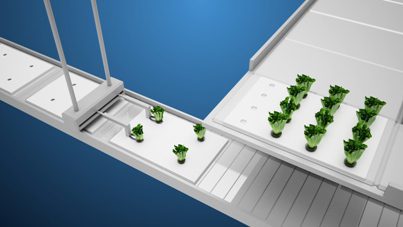Could your next salad from indoor farming with hydroponics be grown by a robot? Perfecting such a piece of equipment is no small task. One that engineers all over the globe have struggled with for years. You see, a robot farmer is highly complex, requiring a lot more intelligence and delicacy of motion than, say, a robotic vacuum or self-driving cars.
However, hydroponic indoor farming is far more robot-friendly than outdoor agriculture. Which is why there’s no huge influx of robots in traditional farming. They have problems with the unstructured layout, ruining the crop during harvest, and so forth. Robotic arms harvesting field-grown lettuce is still a distant dream. But change the environment to an indoor farm, and conquering the complexities gets far easier. Especially, it seems, when the crop is lettuce and greens.

Recently, Silicon Valley startup Iron Ox announced their indoor farming robot with an anticipated working model date in 2018. The technology team is well put together. CEO Brandon Alexander is a former farm boy and Google X engineer. Co-founder Jon Binney holds a Ph.D. in robotics. Their shared interests and collective experience inspired them to take up the challenge of making indoor farm lettuce cost as little as its field-grown competition.
From the planning stages in 2016 through today they’ve kept a keen eye on reducing the cost of growing food and ensuring that its super fresh upon reaching the market. Their current indoor farming facility sits midway between two major markets, San Francisco and San Jose with fast access to major freeways. But with all the media coverage talking about their system and robotics being designed for use in greenhouses, I suspect the current industrial park location is temporary. Not having to pay for grow lights and the energy they consume is a big part of their cost-reduction plan. However, that savings might not work out well in cold climates between cloud cover and the heating bill.
The robot’s design allows it to handle fast-growing crops like lettuces, herbs, and leafy greens. Its programming and equipment automate the entire crop cycle from seed to harvest. And it looks like they have more than one kind of robot in use. First, there’s the farm hand robot with cameras that allow it to spot problems with plant health, pests, and diseases far faster than with human workers. The camera can also measure plant development with 3D imaging, so the robot will know when to move seedlings and when to harvest full-grown plants. And how does it know these things? Not from a database but by learning how to identify problems and do their job. And then there’s a robot with specially designed wheels that allow it to move in any direction for transporting full growing tables of plants around. You’ll see them in action in the video below.
[/et_pb_text][et_pb_code admin_label=”Video” _builder_version=”3.0.83″]<script async src=”//player-backend.cnevids.com/script/video/5a0f47ad148bb0100600000f.js?iu=/3379/wiredcom.dart/share”></script>[/et_pb_code][et_pb_text _builder_version=”3.0.83″]
While I’d love to share a lot more details, unfortunately, Iron Ox is keeping most of that proprietary information under their hats. Can you blame them? It’s not much different than what Spread in Japan is sharing with the media. We covered their robotic indoor farming facility almost 2 years ago. Which, I might add, is still in the development stage. The plan to launch the lettuce factory this fall didn’t pan out. Why? Because designing a robot farmer is a lot more complex than they anticipated! But their Tech Farm Keihanna facility in Kizugawa, Kyoto will open at full capacity sometime in 2018.

The question came up in the office here at GCM… Do the two indoor farming robot systems function the same? Scouting around for some media photos brought me to the conclusion that they do not. But Iron Ox isn’t using a vertical farming setup and Spread is. So, the systems would definitely have to have a different design and capabilities. I did find this one image showing Spread’s robot moving plants around the factory on a conveyor. That doesn’t mean that Iron Ox won’t use this method of moving the crop around. With future goals including operating full acre facilities, mass movement is coming as they grow. After all, an army of R2D2 farm hands would not be cost-effective.
Iron Ox’ hydroponic set-up is completely custom-designed and fabricated in-house. The net cups are made to fit robotic hands, which solve the problem of robots bruising or mangling the harvest. And from their current job opening descriptions, the company is already working on the design of a new urban farming location. There will be more of them. Perhaps a lot more. Once perfected, Brandon and John have plans to spread Iron Ox locations to major urban areas across the United States.
Learn More:
- Quartz
- Wired (source)
- Spread Robotic Farm Update
Images courtesy of video screen capture, Avant Global, and Deloitte (respectively).
[/et_pb_text][/et_pb_column][/et_pb_row][/et_pb_section]